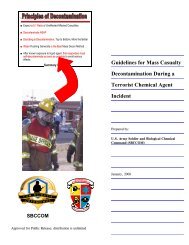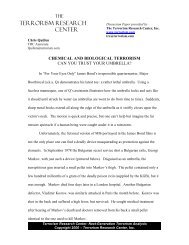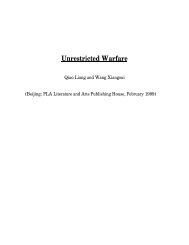Combating Proliferation of Weapons of Mass Destruction
Combating Proliferation of Weapons of Mass Destruction
Combating Proliferation of Weapons of Mass Destruction
You also want an ePaper? Increase the reach of your titles
YUMPU automatically turns print PDFs into web optimized ePapers that Google loves.
esolved before the meetings occur. Supporters <strong>of</strong> this option cite several programsthat have benefited from Vice Presidential authority, such as the Space Council(since the time <strong>of</strong> Vice President Johnson) and the Reinventing Government program<strong>of</strong> Vice President Gore. Others point out that Vice Presidents are <strong>of</strong>ten chosen forreasons having nothing to do with their interest in or qualifications for leading a majornational security effort. Moreover, there is a danger in building a staff structure underthe Vice President that is separate from the NSC.8. Assign responsibility for proliferation to a National Director for <strong>Combating</strong><strong>Proliferation</strong> within the National Security Council, with the rank <strong>of</strong> DeputyAssistant to the President. This model establishes a senior individual inside thenational security apparatus with the authority and responsibility to coordinate thedevelopment and implementation <strong>of</strong> interagency policies and programs bearing onproliferation-related threats. It embeds this effort within the NSC structure to ensureintegration with our overall security and foreign policy and to take advantage <strong>of</strong> theNSC’s traditional role <strong>of</strong> bringing relevant agencies together at all levels, from theworking level up to the Principals. It elevates the stature <strong>of</strong> proliferation-relatedefforts in the NSC and assigns a correspondingly enhanced role in resolvingdifferences between agencies, setting priorities for agency activities, and allocatingresources within existing congressional authorities. Execution <strong>of</strong> programs wouldremain with agencies.Critics <strong>of</strong> this model express doubt that a member <strong>of</strong> the NSC staff, even one with therank <strong>of</strong> Deputy Assistant to the President, can direct Cabinet agencies or resolvedisputes between Cabinet secretaries. Moreover, they point out that directiveauthority without control over budget resources is tenuous, but that the NSC shouldnot be involved in executing budgets. In addition, such direct budget authority wouldlikely require that the <strong>of</strong>ficial be appointed by the President with the advice andconsent <strong>of</strong> the senate.9. Work to improve the present system and organizational structure. TheCommission was mindful <strong>of</strong> the first rule <strong>of</strong> any effort to change organizations andsystems: do no harm. Some felt the disadvantages inherent in each <strong>of</strong> the proposalsconsidered by the Commission argued in favor <strong>of</strong> leaving the existing system inplace, on the theory that individuals <strong>of</strong> good will can work together in the existingframework through both formal and ad hoc interagency mechanisms. Theysuggested that the interagency process works well and is getting better at dealingwith the emerging threats <strong>of</strong> proliferation, terrorism, and infrastructure protection.Finally, advocates <strong>of</strong> this view note that there are other important issues that cutacross several agencies and require coordination, and that it is impractical to seek tosolve each such cross-cutting issue with a new interagency organizational structure.12







